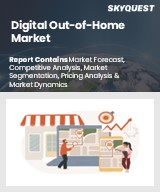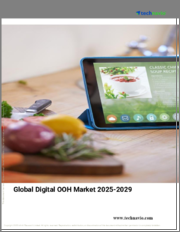
|
시장보고서
상품코드
1758579
디지털 옥외 광고(DooH) 시장 : 시장 규모, 점유율, 성장 분석 - 제품별, 조직 규모별, 용도별, 최종 사용자별, 지역별 산업 예측(2025-2032년)Digital Out-of-Home Market Size, Share, and Growth Analysis, By Product, By Organization Size, By Application, By End User, By Region -Industry Forecast 2025-2032 |
||||||
세계의 디지털 옥외 광고(DooH) 시장 규모는 2023년에 245억 달러로 평가되었고, 2024년 275억 9,000만 달러에서 2032년에는 712억 9,000만 달러로 성장할 전망이며, 예측 기간인 2025-2032년 CAGR 12.6%로 성장할 전망입니다.
세계의 디지털 옥외 광고(DooH) 시장은 프로그래매틱 광고, AI 주도의 컨텐츠 개별화, 실시간 시청자 분석 등의 첨단 기술 통합 증가에 따라 강력한 성장을 이루고 있습니다. 브랜드가 기존의 광고 모델에서 점점 이동하는 가운데, DOOH는, 교통기관의 허브, 쇼핑 센터, 도시부의 빌보드(간판) 등, 인적이 많은 장소에서 소비자를 효과적으로 끌어당기는, 다이나믹하고 타겟을 좁힌 인터랙티브한 캠페인을 제공하고 있습니다. 도시화의 급속한 진전 및 디지털 미디어를 접하는 소비자의 증가가 맞물려 DOOH 솔루션의 채택이 더욱 진행되고 있습니다. 게다가 스마트 인프라와 5G 네트워크의 보급으로 디지털 디스플레이 전체에 대한 원활한 연결과 데이터 주도의 콘텐츠 전달이 가능해지고 있습니다. 또, 에너지 효율이 높은 디스플레이나 인쇄 비용의 삭감에 의해, 환경적으로 지속 가능한 디지털 사이니지로의 시프트가 현저하게 되고 있습니다. 미디어 오너나 광고주가 자동화, 실시간 입찰, 측정 가능한 ROI에 주력하는 가운데, DOOH의 상황은 급속히 업계 전체의 옴니채널 마케팅 전략의 중요한 기둥으로 변화하고 있습니다.
목차
서문
- 분석 목적
- 시장 범위
- 정의
분석 기법
- 정보 조달
- 2차 및 1차 데이터의 수법
- 시장 규모 예측
- 시장의 상정 및 제약
주요 요약
- 시장 개요 및 전망
- 수급 동향의 분석
- 부문별 기회 분석
시장 역학 및 전망
- 시장 개요
- 시장 규모
- 시장 역학
- 성장 촉진요인 및 기회
- 성장 억제요인 및 과제
- Porter's Five Forces 분석
주요 시장 인사이트
- 주요 성공 요인
- 경쟁도
- 주요 투자 기회
- 시장 생태계
- 시장 매력도 지수(2024년)
- PESTEL 분석
- 거시경제지표
- 밸류체인 분석
- 가격 분석
세계의 디지털 옥외 광고(DooH) 시장 규모 및 CAGR : 포맷 유형별(2025-2032년)
- 시장 개요
- 빌보드
- 교통기관
- 스트리트 패니처
- 기타
세계의 디지털 옥외 광고(DooH) 시장 규모 및 CAGR : 용도별(2025-2032년)
- 시장 개요
- 실내
- 옥외
세계의 디지털 옥외 광고(DooH) 시장 규모 및 CAGR : 최종 사용자별(2025-2032년)
- 시장 개요
- 자동차
- 퍼스널케어 및 가정용품
- 엔터테인먼트
- 소매업
- 식품 및 음료
- 통신
- BFSI
- 기타
세계의 디지털 옥외 광고(DooH) 시장 규모 및 CAGR(2025-2032년)
- 북미
- 미국
- 캐나다
- 유럽
- 독일
- 스페인
- 프랑스
- 영국
- 이탈리아
- 기타 유럽
- 아시아태평양
- 중국
- 인도
- 일본
- 한국
- 기타 아시아태평양
- 라틴아메리카
- 브라질
- 기타 라틴아메리카
- 중동 및 아프리카
- GCC 국가
- 남아프리카
- 기타 중동 및 아프리카
경쟁 구도
- 상위 5개사 비교
- 주요 기업의 시장 포지셔닝(2024년)
- 주요 기업이 채용한 전략
- 시장의 최근 동향
- 주요 기업의 시장 점유율(2024년)
- 주요 기업 프로파일
- 기업 개요
- 제품 포트폴리오 분석
- 부문별 점유율 분석
- 수익의 전년대비 비교(2022-2024년)
주요 기업 프로파일
- JCDecaux(France)
- Clear Channel Outdoor Holdings, Inc.(USA)
- OUTFRONT Media Inc.(USA)
- Lamar Advertising Company(USA)
- Daktronics Inc.(USA)
- Broadsign International LLC(Canada)
- Vistar Media(USA)
- Samsung Electronics Co., Ltd.(South Korea)
- LG Electronics Inc.(South Korea)
- Absen Optoelectronic Co., Ltd.(China)
- Leyard Optoelectronic Co., Ltd.(China)
- Unilumin Group Co., Ltd.(China)
- Barco NV(Belgium)
- AOTO Electronics Co., Ltd.(China)
- MPI Corporation(Taiwan)
- Ayuda Media Systems(Canada)
- OneScreen.ai(USA)
결론 및 권고
AJY 25.07.04Global Digital Out-of-Home Market size was valued at USD 24.5 billion in 2023 and is poised to grow from USD 27.59 billion in 2024 to USD 71.29 billion by 2032, growing at a CAGR of 12.6% during the forecast period (2025-2032).
The Global Digital Out-of-Home (DOOH) Market is witnessing robust growth driven by the rising integration of advanced technologies such as programmatic advertising, AI-driven content personalization, and real-time audience analytics. As brands increasingly shift away from traditional advertising models, DOOH offers dynamic, targeted, and interactive campaigns that effectively engage consumers in high-traffic locations such as transit hubs, shopping centers, and urban billboards. The surge in urbanization, combined with growing consumer exposure to digital media, is further enhancing the adoption of DOOH solutions. Additionally, the proliferation of smart infrastructure and 5G networks is enabling seamless connectivity and data-driven content delivery across digital displays. The market is also seeing a notable shift towards environmentally sustainable digital signage, driven by energy-efficient displays and reduced printing costs. With media owners and advertisers focusing on automation, real-time bidding, and measurable ROI, the DOOH landscape is rapidly transforming into a key pillar of omnichannel marketing strategies across industries.
Top-down and bottom-up approaches were used to estimate and validate the size of the Global Digital Out-of-Home market and to estimate the size of various other dependent submarkets. The research methodology used to estimate the market size includes the following details: The key players in the market were identified through secondary research, and their market shares in the respective regions were determined through primary and secondary research. This entire procedure includes the study of the annual and financial reports of the top market players and extensive interviews for key insights from industry leaders such as CEOs, VPs, directors, and marketing executives. All percentage shares split, and breakdowns were determined using secondary sources and verified through Primary sources. All possible parameters that affect the markets covered in this research study have been accounted for, viewed in extensive detail, verified through primary research, and analyzed to get the final quantitative and qualitative data.
Global Digital Out-of-Home Market Segments Analysis
The global digital out-of-home market is segmented into product, application, organization size, end user, and region. By product, the market is classified into digital billboard, digital signage, and digital screens. Depending on organization size, it is bifurcated into large & medium enterprises and small enterprises. According to the application, the market is divided into indoor and outdoor. As per end user, it is categorized into retail, healthcare, BFSI, automotive, government, media & entertainment, and food & beverages. Regionally, it is analyzed across North America, Europe, Asia-Pacific, Latin America, and the Middle East & Africa.
Driver of the Global Digital Out-of-Home Market
The global digital out-of-home (DOOH) market is undergoing significant transformation, driven by rapid advancements in artificial intelligence, data analytics, and digital display technologies. These innovations enable advertisers to develop sophisticated, interactive campaigns that enhance targeting and measurability, fostering greater trust from advertisers in their strategies. Various sectors are recognizing that real-time messaging and dynamic content significantly elevate audience engagement. The rise of AI-driven programmatic advertising is further propelling market growth, as it allows for the optimization of ads, resulting in improved performance and broader distribution. This synergy of technology and creativity is reshaping the landscape of outdoor advertising.
Restraints in the Global Digital Out-of-Home Market
The Global Digital Out-of-Home (DOOH) market faces certain constraints primarily linked to the high costs associated with advanced technology installations. Significant investments are required for software and hardware, creating substantial entry barriers for small businesses and startups, especially in developing nations. Additionally, ongoing maintenance and necessary technology upgrades contribute to elevated operational expenses. Consequently, potential investors may hesitate to allocate funds towards costly infrastructure without guaranteed returns, leading to a slower adoption rate in certain regions. This hesitance ultimately restrains overall growth within the market, as the reluctance to invest hampers the widespread implementation of DOOH solutions.
Market Trends of the Global Digital Out-of-Home Market
The Global Digital Out-of-Home (DOOH) market is witnessing a significant trend towards the expansion of programmatic advertising, which harnesses real-time audience and contextual data for automated ad buying. This advancement enhances ad performance by minimizing human error and maximizing operational efficiency. Advertisers are increasingly gravitating towards programmatic platforms that allow for the dynamic adjustment of advertisements in real-time, thereby improving return on investment. As a result, programmatic DOOH is set to transform campaign management and drive substantial growth in the global market, especially in regions with advanced technological infrastructure, solidifying its pivotal role in the future of advertising.
Table of Contents
Introduction
- Objectives of the Study
- Scope of the Report
- Definitions
Research Methodology
- Information Procurement
- Secondary & Primary Data Methods
- Market Size Estimation
- Market Assumptions & Limitations
Executive Summary
- Global Market Outlook
- Supply & Demand Trend Analysis
- Segmental Opportunity Analysis
Market Dynamics & Outlook
- Market Overview
- Market Size
- Market Dynamics
- Drivers & Opportunities
- Restraints & Challenges
- Porters Analysis
- Competitive rivalry
- Threat of substitute
- Bargaining power of buyers
- Threat of new entrants
- Bargaining power of suppliers
Key Market Insights
- Key Success Factors
- Degree of Competition
- Top Investment Pockets
- Market Ecosystem
- Market Attractiveness Index, 2024
- PESTEL Analysis
- Macro-Economic Indicators
- Value Chain Analysis
- Pricing Analysis
Global Digital Out-of-Home Market Size by Format Type & CAGR (2025-2032)
- Market Overview
- Billboard
- Transit
- Street Furniture
- Others
Global Digital Out-of-Home Market Size by Application & CAGR (2025-2032)
- Market Overview
- Indoor
- Outdoor
Global Digital Out-of-Home Market Size by End User & CAGR (2025-2032)
- Market Overview
- Automotive
- Personal Care and Households
- Entertainment
- Retail
- Food and Beverages
- Telecom
- BFSI
- Others
Global Digital Out-of-Home Market Size & CAGR (2025-2032)
- North America (Format Type, Application, End User)
- US
- Canada
- Europe (Format Type, Application, End User)
- Germany
- Spain
- France
- UK
- Italy
- Rest of Europe
- Asia Pacific (Format Type, Application, End User)
- China
- India
- Japan
- South Korea
- Rest of Asia-Pacific
- Latin America (Format Type, Application, End User)
- Brazil
- Rest of Latin America
- Middle East & Africa (Format Type, Application, End User)
- GCC Countries
- South Africa
- Rest of Middle East & Africa
Competitive Intelligence
- Top 5 Player Comparison
- Market Positioning of Key Players, 2024
- Strategies Adopted by Key Market Players
- Recent Developments in the Market
- Company Market Share Analysis, 2024
- Company Profiles of All Key Players
- Company Details
- Product Portfolio Analysis
- Company's Segmental Share Analysis
- Revenue Y-O-Y Comparison (2022-2024)
Key Company Profiles
- JCDecaux (France)
- Company Overview
- Business Segment Overview
- Financial Updates
- Key Developments
- Clear Channel Outdoor Holdings, Inc. (USA)
- Company Overview
- Business Segment Overview
- Financial Updates
- Key Developments
- OUTFRONT Media Inc. (USA)
- Company Overview
- Business Segment Overview
- Financial Updates
- Key Developments
- Lamar Advertising Company (USA)
- Company Overview
- Business Segment Overview
- Financial Updates
- Key Developments
- Daktronics Inc. (USA)
- Company Overview
- Business Segment Overview
- Financial Updates
- Key Developments
- Broadsign International LLC (Canada)
- Company Overview
- Business Segment Overview
- Financial Updates
- Key Developments
- Vistar Media (USA)
- Company Overview
- Business Segment Overview
- Financial Updates
- Key Developments
- Samsung Electronics Co., Ltd. (South Korea)
- Company Overview
- Business Segment Overview
- Financial Updates
- Key Developments
- LG Electronics Inc. (South Korea)
- Company Overview
- Business Segment Overview
- Financial Updates
- Key Developments
- Absen Optoelectronic Co., Ltd. (China)
- Company Overview
- Business Segment Overview
- Financial Updates
- Key Developments
- Leyard Optoelectronic Co., Ltd. (China)
- Company Overview
- Business Segment Overview
- Financial Updates
- Key Developments
- Unilumin Group Co., Ltd. (China)
- Company Overview
- Business Segment Overview
- Financial Updates
- Key Developments
- Barco NV (Belgium)
- Company Overview
- Business Segment Overview
- Financial Updates
- Key Developments
- AOTO Electronics Co., Ltd. (China)
- Company Overview
- Business Segment Overview
- Financial Updates
- Key Developments
- MPI Corporation (Taiwan)
- Company Overview
- Business Segment Overview
- Financial Updates
- Key Developments
- Ayuda Media Systems (Canada)
- Company Overview
- Business Segment Overview
- Financial Updates
- Key Developments
- OneScreen.ai (USA)
- Company Overview
- Business Segment Overview
- Financial Updates
- Key Developments



















